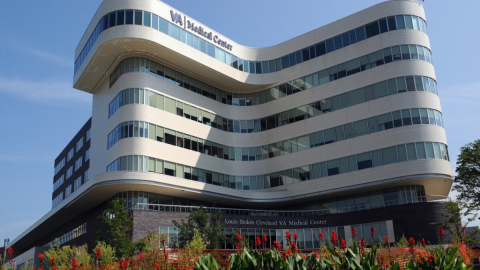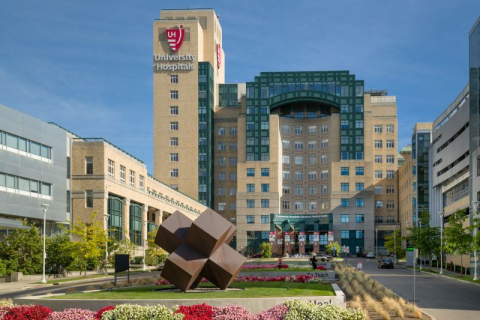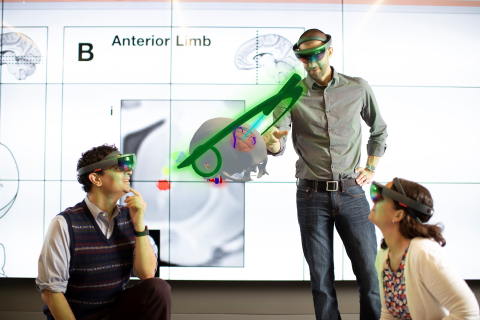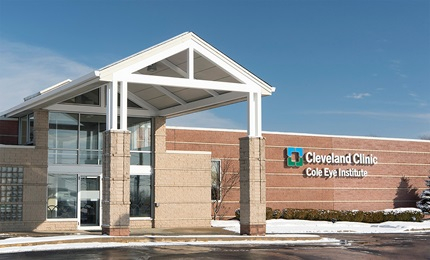Discover facilities used by the Shaikh Lab in the Department of Neurology at Case Western Reserve University School of Medicine.
Cleveland VA Medical Center – National VA PD Consortium Center
The Louis Stokes Cleveland VA Medical Center (LSCVAMC) is the largest VA medical center in VISN10 and the primary VA rehabilitation center in Ohio. The LSCVAMC serves more than 134,000 veterans each year with more than 11,000 admissions annually. The inpatient tertiary care facility at Wade Park has over 200 acute medical and surgical hospital beds, 190 acute and sub-acute rehabilitation beds and 174 residential beds and 150 mental health beds and 100 outpatient clinics. The LSCVAMC also has 13 satellite clinics throughout Northeast Ohio. These satellite clinics in addition to the VA facilities in western New York, western Pennsylvania, southern and southeastern Michigan, northern Kentucky, and Ohio are the sources of Parkinson patient referral in the Cleveland VA movement disorders clinic that is now part of National VA PD Consortium Center.
This VA Center for Excellence directed by Dr. Shaikh is only one of such centers in VISN 10. The center comprises 15 neurology faculty, one nurse practitioner, one social worker, one psychiatrist, two movement disorders fellows, and 36 rotating neurology residents; 20% of new neurological outpatient consultations are for movement disorders. We see about 1000 new patients and 5000 follow up PD patients at Cleveland VA and its satellite centers.
In addition to providing excellent medical care, the administration at the LSCVAMC has a long history of supporting medically relevant research. The LSCVAMC is a major teaching affiliate of Case Western Reserve University and is an affiliate partner in the Clinical and Translational Science Collaborative of Cleveland (CTSC) which is helping to advance biomedical research and accelerate community health research across Greater Cleveland. LSCVAMC continues to improve the facilities and the opportunities for investigators conducting projects related to health care. Dedicated research building is a testimonial to this, as are the intimate involvement of key administrators in the research enterprise, for example the station chief of staff routinely attends the R&D Committee meetings. The LSCVAMC Human Subject’s Protection program is conducted under the most rigorous ethical standards in order to assure the protection of the rights, welfare, and safety of the patients under our care.
University Hospitals Health System
In addition to the VA neurology clinic, the research study patients will also be recruited from the University Hospitals Health System. University Hospitals is one of the largest healthcare systems in Ohio, and the main campus (University Hospitals Cleveland Medical Center) is within 1 mile distance from our research laboratory. The University Hospitals Health System also owns 12 community hospitals and 32 outpatient facilities around the Cleveland Metropolitan area. The Deep Brain Stimulation (DBS) surgeries are performed in one of the two dedicated operating rooms in the Lerner Tower of the University Hospital Cleveland Medical Center.
Dr. Shaikh is part of a team of two functional neurosurgeons and three neurophysiology trained movement disorders neurologists. University Hospitals is a major referral center for surgical treatment of movement disorders. At University Hospitals we perform approximately 50 such surgeries per year.
Daroff-Dell’Osso Eye Movement Physiology Laboratory
Proposed research will be conducted at the Daroff-Dell’Osso Motor Physiology Laboratory (DDOM Lab) at the LSCVAMC. The laboratory consists of 3066 sq. ft. housing five rooms for recording human eye movements. In addition, there is office space for the PI (and three other PIs), four graduate students, two post-doctoral fellows. Biomedical engineers help in testing subjects and patients, assist in collecting experimental data, writing programs for experiments, maintaining electrical and mechanical equipment, and building new devices as required. A 174 sq. ft. machine and electronics shop is adjacent to the lab. A 103 sq. ft. examination room is fitted with equipment for neurological and movement disorders testing of research subjects and patients. A conference room is available onsite for seminars and discussions. A variety of motor systems projects are underway in the lab by other funded investigators, therefore a rich environment for the discussion of the ongoing work is available. Other investigators in the laboratory include Louis F. Dell'Osso, Ph.D. (biomedical engineer), and three clinician scientists: Mark F. Walker, MD; John S. Stahl, MD, PhD, and Alessandro Serra, MD, PhD.
High Performance Computing Facility
The High-Performance Computing Facility at the LSCVAMC is a local computational resource for musculoskeletal modeling, biomechanical simulation and controller design. This is a state-of-the-art computational facility that serves as a central resource for the high performance computing requirements of several biomechanical researchers associated with the APT Center.
Dr. Shaikh has full access to this facility and will utilize it for computational analysis, software algorithm development, and signal processing. This facility is equipped with state of the art super-computing facilities such as a 16-processor supercomputer - Fusion A8 server with eigh dual core processors and two new super-computers (HPX QS8-8500) each running with 32 AMD Opteron processors. Put together, these give us a cluster with a total of 72 processors that can be run in parallel, suitable for all kinds of rapid dynamic optimization studies. The computational resources at the Ohio Supercomputer Center (OSC) and the Case High Performance Computing Cluster (Case HPC) are also available for the modeling, simulation and design work. Both facilities provide parallel computing facilities that allow the solution of a wide variety of optimization problems that would otherwise be difficult with stand-alone computers.
Cleveland Functional Electrical Stimulation Center (The FES Center):
The FES Center stands as the world's most comprehensive and unified program dedicated to Functional Electrical Stimulation (FES) research. Our investigations span from fundamental to applied realms, covering a wide array of applications. FES, also known as neuromodulation, involves the precise application of low-level electrical pulses to the central or peripheral nervous system. These pulses mimic neuronal actions, compensating for damage caused by injury or disease. By effectively communicating with the nervous system, FES can activate or deactivate specific elements, such as peripheral nerves, the spinal cord, or the brain, eliciting desired responses.
Ocular Motility and Vision Neuroscience Lab at Cole Eye Institute
Dr. Ghasia directs the Ocular Motility Laboratory (1200 sq. ft.) adjacent to the Cole Eye Institute building. The laboratory has a dedicated parking lot allowing easy access to patients. The laboratory features two rooms with independently dimmable lighting, enabling the creation of luminance-controlled environments for vision experiments. The lab is spacious enough to enable subjects to view distant stimuli and to accommodate several eye movements recording setups simultaneously. Electrical outlets and networking connections are abundant, enabling equipment to be set up to suit evolving needs.





